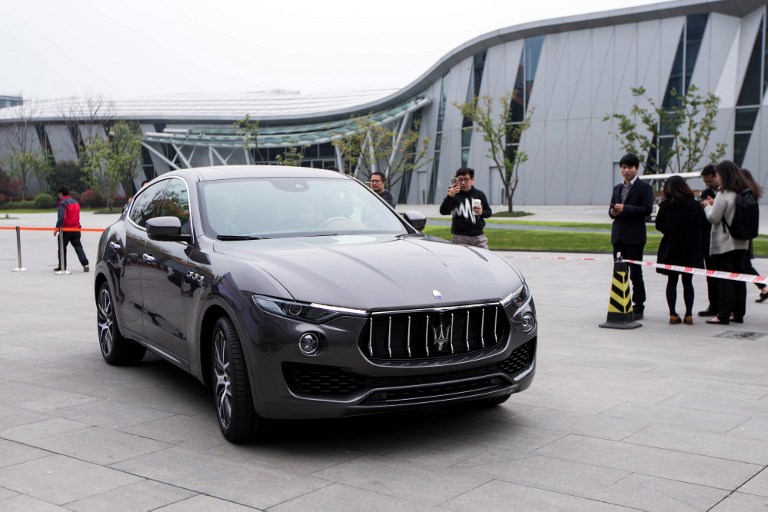Global carmakers see rising competition in China

This photo taken on March 23, 2016 shows people taking photos of a Maserati Levante sport-utility vehicle in Hangzhou, eastern China’s Zhejiang province. Chinese drivers are rushing to buy sport-utility vehicles in an “arms race” for safety on the country’s hair-raising roads, analysts say, as SUV sales hit the gas despite a slowing economy. AFP
BEIJING — Global carmakers gathered in Beijing on Monday to show off their wares as competition intensifies and growth slows in the world’s biggest auto market, with the key SUV and new energy vehicle sectors the focus of attention.
The flamboyant show, which alternates between the capital and commercial hub Shanghai, came after auto sales in China grew just 4.7 percent last year, down from 6.9 percent in 2014, data from industry group China Association of Automobile Manufacturers (CAAM) showed.
Total sales reached 24.6 million in 2015, making it a crucial market for foreign manufacturers as well as domestic brands.
“It is slowing down,” Ford China chairman and CEO John Lawler told reporters. “The market is really acting more and more like a mature market rather than an emerging market.
“It is part of a more competitive environment.”
Article continues after this advertisementMore than 70 exhibits by automakers from around the world stretched across the vast exhibition center with crowds gawking at displays of concept cars from Chevrolet and Faraday Future and lining up to slip behind the wheel of a Tesla.
Article continues after this advertisementPerhaps the most attention-grabbing exhibit was homegrown startup Qiantu, which plans to launch its K50 concept vehicle — a carbon fibre and aluminium-bodied luxury electric sports car — next year.
Models in short flight-attendant style skirts — but not bikinis which are banned this year — stood with frozen smiles as passers-by took photos with their phones.
German manufacturer Audi has an enviable brand position in China and has long been seen as a marque to aspire to by consumers, but it too is feeling the pressure.
“For sure, our competitors are trying to grab market shares from us, and some are successful,” said Joachim Wedler, president of Audi China. “This is business, we have to struggle and fight.”
Pricing was “getting tougher, this is obvious” he said.
Hybrid vigor
China’s GDP growth slowed to 6.9 percent last year, its lowest for a quarter of a century, and worries over its outlook have roiled stock markets worldwide.
But sales of sports utility vehicles (SUVs) and electric and hybrid cars have boomed, far outperforming other types of autos.
SUV sales surged 52.4 percent in 2015 while shipments of electric and hybrid cars — grouped together as “new energy” — more than quadrupled, CAAM figures showed.
Sales of Chinese brand SUVs — most of them much cheaper than foreign models — rose 82.8 percent year-on-year, giving them the majority of the market in the sector.
Car ownership penetration remains below 30 percent of households in the world’s most populous country, pointed out Hiroji Onishi, Toyota China head.
“Compared to home appliances and mobile phones, this is still a very low rate, so the car market is still a market for the future,” he said. “We can say that China is still in the midst of motorisation.”
The loosening of the one-child policy to allow all couples two offspring could see demand rise for larger vehicles such as minivans, he said. “We need to think of these possibilities and prepare.”
Executives also point to high-end growth potential among the affluent, relatively youthful elite.
Daimler board member Hubertus Troska, who is responsible for Greater China, pointed out that the average Mercedes customer in the country was aged just 37.
“Premium customers in China are the youngest in the world,” he said. “They’re internet savvy, we really want to be at the forefront of connectivity and telematics in this country.”
RELATED STORIES
BMW enjoys luxury car boost but cautions over China